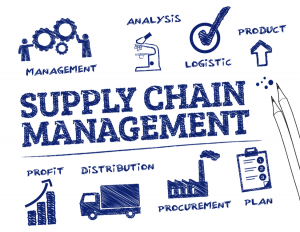6 Small Supply Chain Issues That Can Topple Your Entire Operation
This is a guest post by Jake Rheude.
 Like a line of dominoes, one small failure can bring down the entire structure. That’s the nature of the modern logistics environment for many businesses, and failures can happen in a lot of different areas, from inventory management to the partners you work with.
Like a line of dominoes, one small failure can bring down the entire structure. That’s the nature of the modern logistics environment for many businesses, and failures can happen in a lot of different areas, from inventory management to the partners you work with.
However, many risks can be spotted when they’re small and mitigated early by being proactive and responsive. And, “thanks” to the global pandemic and all the issues it brought, risk management in the supply chain is more important now than ever. We’ve put together a few helpful hints and tips to tackle seven of the most common small supply chain issues that can get out of control if not treated early.
1. Your Data Is Siloed
Modern supply chains run on data. You don’t need to be looking at blockchain solutions from Maersk or IBM, but you should know what data you have, what your partners have, and how to use it all. And you should know that it is all useless if it doesn’t integrate. Closed systems severely limit your options for data movement.
We’ve seen a massive push for lean supply chains across the last decade, and data is the main driving force behind these capabilities. Fixing black holes and gaps in data sharing enables you to have the most up-to-date information for decision making. You can immediately know when to switch suppliers if there are errors with a delivery or even if there are issues with raw materials.
Busting silos also helps you work within fewer systems and dashboards to know where you stand. You no longer need experts on 20 pieces of software, just reliable practitioners on your SCM or ERP tools.
2. Manual Tasks Dominate Supply Chain Issues
Humans make mistakes, and the more manual tasks you have clogging up your supply chain, the more mistakes will be made. You can incentivize your employees as much as possible towards being as accurate as possible, but it will never be perfect.
Automation and other leading technology options allow your company to move forward and protect orders, customers, and inventory from mistakes. You can minimize the chance of stock-outs and overages while making sure the right goods go out on the right day to meet orders. You can even expand capabilities as orders scale but you’re not yet ready to hire more staff.
One of the biggest areas we see a benefit from automation is when products are returned or orders are cancelled — especially if they’re cancelled while we’re picking them. Automated inventory systems that link up to handheld scanners can tell a picker or packer to stop immediately. They can give your team directions to add something back to inventory and, with one scan, goods are put back into the system while inventory levels are adjusted, and you can use it for the next order.
A process that could be seven or more steps when done manually is now accomplished with a person scanning a product and putting it on a shelf.
3. Single Points of Failure
A single point of failure sounds like a major issue, and it definitely is, but these issues tend to start out small and be hard to notice until everything comes crashing down. A review of your supply chain can catch them, but only if you’re thorough.
What you want to identify is both the individual elements that can cause failure and associated vendors. Let’s say, for instance, you just have one source of labels for the brand-new printers you’ve added to your lines. If the supplier of those labels misses a shipment, you might have local stores to send someone to so you can buy the right options. Or you might be able to find a local supplier easily if they’re common. It gives you plenty of ways to plan for and protect operations, especially in the last-mile as well as the first mile.
As you review and identify issues, look for websites that can help you find local providers, training, and components. There are many services that will help you compare vendors and products based on reviews and production capabilities. Plus, you might be able to find options for vertical integration that can overcome issues around product sourcing.
4. Omni-channel Isn’t Part of Your Game Plan
The buying habits of consumers are changing in major ways, with ecommerce significantly impacting B2B and the demand for quality increases as supply increases.
As you increase your B2B conversions, you’re going to need a plan to handle omnichannel supply chain issues.
Look for opportunities or requests from customers and partners to develop direct-to-consumer fulfillment needs. You might even uncover new sales opportunities by being a provider of goods to drop shippers or running a drop shipping business yourself.
Supply chains are running leaner every year and keeping that running smoothly means having a plan for the orders you will take tomorrow and six months from now, from all possible channels.
5. Warehouse Space and Scarcity
What do you do when your warehouse is packed, filled with products that sit on the shelf for months?
When a product is returned, does it get added back to your inventory, or does it sit on a shelf in the back in an area that slowly grows while you keep saying, “We’ll get to that pile eventually?”
The warehouse is a big opportunity for logistics savings and maximization, but that also means it’s a common area for supply chain issues. A lot can go wrong and that scales costs, especially if you take up inventory space with things that don’t sell. This limits your stock of what does sell well, reducing overall profit potential as storage costs rise.
6. Planning for Carrier Changes
Every year we see changes to the shipping rates from major carriers around the world. Here in the U.S., 2020 will likely continue to see a significant shift in both general rate increases as well as a variety of surcharge increases.
If your supply chain isn’t keeping track of changes, you might face a sharp and unexpected rise in your costs that harms flexibility and inventory options. Always read the fine print and adapt because there’s a chance that a major shift will impact only some of your products and shipments, making long-term planning difficult.
Like many supply chain issues we’ve discussed, this one is all about preparation.
For the companies that we work with, one of the hidden dangers is a change to the FedEx and UPS surcharge on heavy packages. Now, the starting weight for this charge will be 50 pounds instead of 70 pounds, which could double the number of packages that are subject to the weight surcharge. Adding that to increased handling surcharges, delivery area surcharges, fees for rebilling, and a bump in cost for non-stackable packages, and you might be facing a major spike in your line items.
Knowing these changes may also help you save money down the road. If your shipments meet some of these cutoffs, prices will climb significantly, and you may be able to save by turning some or all shipments over to a 3PL who specializes in your area. Their volume and expertise can mitigate some of these cost increases.
This was a guest post by Jake Rheude.
 Author Bio
Author Bio
Jake Rheude is the Director of Marketing for Red Stag Fulfillment, an ecommerce fulfillment warehouse that was born out of ecommerce. He has years of experience in ecommerce and business development. In his free time, Jake enjoys reading about business and sharing his own experience with others.




